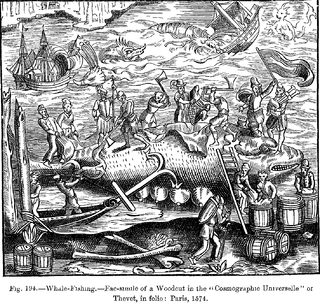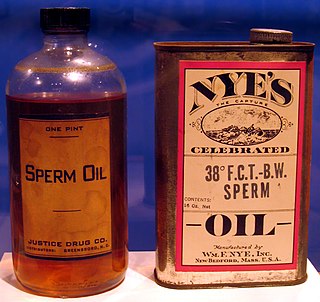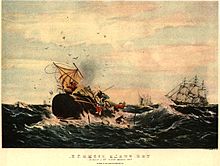
The sperm whale or cachalot is the largest of the toothed whales and the largest toothed predator. It is the only living member of the genus Physeter and one of three extant species in the sperm whale family, along with the pygmy sperm whale and dwarf sperm whale of the genus Kogia.

Spermaceti is a waxy substance found in the head cavities of the sperm whale. Spermaceti is created in the spermaceti organ inside the whale's head. This organ may contain as much as 1,900 litres (500 US gal) of spermaceti. It has been extracted by whalers since the 17th century for human use in cosmetics, textiles, and candles.

This article discusses the history of whaling from prehistoric times up to the commencement of the International Whaling Commission (IWC) moratorium on commercial whaling in 1986. Whaling has been an important subsistence and economic activity in multiple regions throughout human history. Commercial whaling dramatically reduced in importance during the 19th century due to the development of alternatives to whale oil for lighting, and the collapse in whale populations. Nevertheless, some nations continue to hunt whales even today.

A whaleboat is a type of open boat that was used for catching whales, or a boat of similar design that retained the name when used for a different purpose. Some whaleboats were used from whaling ships. Other whaleboats would operate from the shore. Later whaleboats usually could operate under sail or oar - American whaling crews in particular obtained better results by making their first approach to a whale under sail, then quickly unstepping the mast and using oars thereafter.

Essex was an American whaling ship from Nantucket, Massachusetts, which was launched in 1799. On November 20, 1820, while at sea in the southern Pacific Ocean under the command of Captain George Pollard Jr., the ship was attacked and sunk by a sperm whale. About 2,000 nautical miles (3,700 km) from the coast of South America, the 20-man crew was forced to make for land in three whaleboats with what food and water they could salvage from the wreck.

The Ann Alexander was a three-masted ship from New Bedford, Massachusetts. She is notable for having been rammed and sunk by a wounded sperm whale in the South Pacific on August 20, 1851, some 30 years after the famous incident in which the Essex was stove in and sunk by a whale in the same area.

Mocha Dick was a male sperm whale that lived in the Pacific Ocean in the early 19th century, usually encountered in the waters near Mocha Island, off the central coast of Chile. American explorer and author J. N. Reynolds published his account, "Mocha Dick: Or The White Whale of the Pacific: A Leaf from a Manuscript Journal" in 1839 in The Knickerbocker. Mocha Dick was an albino and partially inspired Herman Melville's 1851 novel Moby-Dick.

In the Heart of the Sea: The Tragedy of the Whaleship Essex is a book by American writer Nathaniel Philbrick about the loss of the whaler Essex in the Pacific Ocean in 1820. The book was published by Viking Press on May 8, 2000, and won the 2000 National Book Award for Nonfiction. It was adapted into a film of the same name, which was released in December 2015.

A whaler or whaling ship is a specialized vessel, designed or adapted for whaling: the catching or processing of whales.

Flensing is the removing of the blubber or outer integument of whales, separating it from the animal's meat. Processing the blubber into whale oil was the key step that transformed a whale carcass into a stable, transportable commodity. It was an important part of the history of whaling. The whaling that still continues in the 21st century is both industrial and aboriginal. In aboriginal whaling the blubber is rarely rendered into oil, although it may be eaten as muktuk.

Sperm oil is a waxy liquid obtained from sperm whales. It is a clear, yellowish liquid with a very faint odor. Sperm oil has a different composition from common whale oil, obtained from rendered blubber. Although it is traditionally called an "oil", it is technically a liquid wax. It is composed of wax esters with a small proportion of triglycerides, an ester of an unsaturated fatty acid, and a branched-chain fatty alcohol. It is a natural antioxidant and heat-transfer agent. In the late-18th and early-19th centuries, sperm oil was prized as an illuminant for its bright, odorless flame and as a lubricant for its low viscosity and stability. It was supplanted in the late 19th century by less expensive alternatives such as kerosene and petroleum-based lubricants. With the 1987 international ban on whaling, sperm oil is no longer legally sold.
A Nantucket sleighride is the dragging of a whaleboat by a harpooned whale while whaling. It is an archaic term from the early days of open-boat whaling, when the animals were harpooned from small open boats. Once harpooned, the whale, in pain from its wound, attempts to flee, but the rope attached to the harpoon drags the whalers' boat along with it. The term refers to Nantucket, Massachusetts, the center of the American whaling industry; as well as the speed associated with riding in a horse-drawn sleigh. The term wasn't used by whalemen themselves, but was probably invented by a late 19th-century journalist.

Commercial whaling in the United States dates to the 17th century in New England. The industry peaked in 1846–1852, and New Bedford, Massachusetts, sent out its last whaler, the John R. Mantra, in 1927. The Whaling industry was engaged with the production of three different raw materials: whale oil, spermaceti oil, and whalebone. Whale oil was the result of "trying-out" whale blubber by heating in water. It was a primary lubricant for machinery, whose expansion through the Industrial Revolution depended upon before the development of petroleum-based lubricants in the second half of the 19th century. Once the prized blubber and spermaceti had been extracted from the whale, the remaining majority of the carcass was discarded.

Nantucket shipbuilding began in the late 1700s and culminated in the construction of notable whaling ships during the early 19th century. Shipbuilding was predominantly sited at Brant Point. Whaling ship construction concluded in 1838.

The Nantucket Whaling Museum is a museum located in Nantucket, Massachusetts. It is run by the Nantucket Historical Association. The Whaling Museum is the flagship site of the Nantucket Historical Association’s fleet of properties.
The whaler Globe, of Nantucket, Massachusetts, was launched in 1815. She made three whaling voyages and then in 1824, on her fourth, her crew mutinied, killing their officers. Eventually most of the mutineers were killed or captured and the vessel herself was back in Nantucket in her owners' hands. She continued to whale until about 1828. She was broken up circa 1830.

Two Brothers was a Nantucket whaleship that sank on the night of February 11, 1823, off the French Frigate Shoals. The ship's captain was George Pollard, Jr., former captain of the famous whaleship Essex. The wreck was discovered in 2008 by a team of marine archaeologists working on an expedition for the National Oceanic and Atmospheric Administration in the Papahānaumokuākea Marine National Monument. She is thought to have been built in 1804 by Joseph Glidden in Hallowell, Maine.
George Pollard Jr. (1791–1870) was the captain of the whalers Essex and Two Brothers, both of which sank. Pollard's life, including his encounter with the sperm whale that sank Essex, served as inspiration for Captain Ahab, the whale-obsessed character in Herman Melville's Moby-Dick.

A drift whale is a cetacean mammal that has died at sea and floated into shore. This is in contrast to a beached or stranded whale, which reaches land alive and may die there or regain safety in the ocean. Most cetaceans that die, from natural causes or predators, do not wind up on land; most die far offshore and sink deep to become novel ecological zones known as whale falls. Some species that wash ashore are scientifically dolphins, i.e. members of the family Delphinidae, but for ease of use, this article treats them all as "drift whales". For example, one species notorious for mass strandings is the pilot whale, also known as "blackfish", which is taxonomically a dolphin.






















